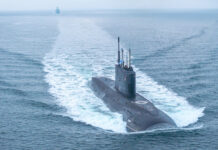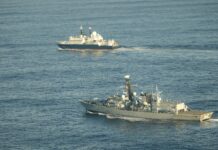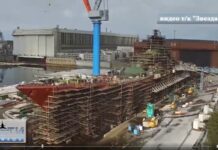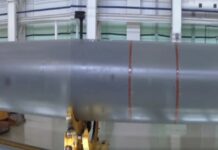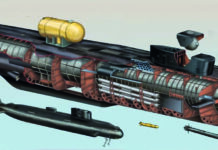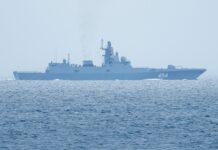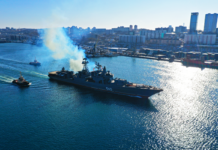
The future of the Russian Navy: will it be able to access the open ocean?
Maxim Starchak
Russian President Vladimir Putin has approved the Russian Navy’s development strategy until 2050: the next step in the development of Russian maritime policy in recent years. The first step was taken in 2022, when Russia’s new maritime strategy was published.
After Nikolai Patrushev, former secretary of the Russian Security Council, assumed the post of chairman of the Russian Maritime Board in 2024, attention increased to the development of shipbuilding and, in particular, the navy. The Office of the President for National Maritime Policy was established and new regulations were adopted.
The new development strategy for the navy until 2050 outlines both the goals for military shipbuilding and the main military and political objectives of the Russian Navy.
Access to the world’s oceans
According to Patrushev, Russia plans to increase its role as a blue-water navy. Despite having a large fleet on paper, Russia’s main focus is on defending its coastal zone and protecting its exclusive economic zone, with little presence in the open ocean. To increase Russia’s blue-water presence, however, the country needs to build more aircraft carriers. Currently, Russia has only one carrier, Admiral Kuznetsov, which is undergoing continuous repairs. There are currently no large-scale Russian shipyards available for building new carriers, but a project is underway to construct one in Vladivostok by 2032. However, according to an expert from the Russian Naval Academy who wished to remain anonymous, this project has not yet been officially approved, meaning that construction could take up to 10 years. It would then take another 10 years to complete the construction, testing, and commissioning process for the proposed new carrier.
Russia has at least three aircraft carrier projects in development, but none has been officially approved. According to the Naval Academy expert, shipboard nuclear reactors, aircraft take-off and landing systems, as well as air defence and electronic jamming systems, are already ready for use on a potential new aircraft carrier. It is estimated that the ship would be able to accommodate up to 90 aircraft and heavy unmanned aerial vehicles (UAVs).
Vladimir Pospelov, a member of the Board of the Military-Industrial Commission, has stated that the lead ship would cost approximately half a trillion rubles (EUR 5.4 billion). However, the Naval Academy expert estimates that the cost could increase to RUB 800 billion or even RUR 1 trillion. Russia will need at least two aircraft carriers, one each for the Northern and Pacific fleets, and possibly a third to replace one of them in case of repair. In total, approximately RUB 2.5 trillion would be required for aircraft carriers and it is still unclear how much will be needed for carrier-based aircraft, which Russia does not currently possess. It is possible that, in the context of potential cuts to the federal budget, aircraft carrier projects will lose out to missile systems, similar to what happened in the Soviet Union, according to Pavel Luzin, a military expert with the Washington-based Center for European Policy Analysis.
Regarding carrier-based aviation, the MiG company has begun developing a new fifth-generation carrier-borne fighter, equipped with an associated UAV. All that is currently known about the aircraft is that it will be a stealthy twin-engined aircraft.
If aircraft carriers are not developed in Russia, deck-based aircraft could be useful for the two universal amphibious assault ships of the Project 23900 Ivan Rogov class that are currently being built. After France refused to sell Mistral-class ships to Russia, Moscow has been forced to develop its own alternatives. So far, they are expected to be able to carry up to 20 helicopters and four UAVs. These ships are scheduled for delivery to the fleet between 2027 and 2028.
For the far seas and ocean regions it is planned to continue building Project 22350 frigates in an upgraded version. According to Admiral Alexander Moiseev, commander-in-chief of the Russian Navy, these frigates will form the backbone of ship formations in the Northern and Pacific fleets. The new design of the frigate has a 30% increase in displacement, a 50% increase in missile capabilities and a doubling of air defence systems. At the first stage of the project, 18 units will be built, complementing the eight Project 22350 frigates from the first design.
Anti-submarine warfare ships
Russia has a longstanding issue with its submarine-hunting capabilities. Currently, the country is in the process of decommissioning smaller anti-submarine warfare (ASW) corvettes that were built during the Soviet era. Until 2014 Russia was producing Buyan-M-class corvettes to replace them, but following international sanctions imposed in 2014 Russia lost access to German powerplants, which led to the development of the fully domestic Project 22800 Karakurt-class corvette. This new design has increased seaworthiness, improved navigation autonomy, enhanced air defence capabilities, and upgraded radar and sonar systems. Of the 18 vessels planned, 16 have already been completed or are currently under construction.
Russia’s corvette plans call for modernisation and a doubling of their number. The new, upgraded corvettes will have ASW systems, torpedo protection equipment and, instead of one missile launcher, they will have three for Kalibr and Zircon attack missiles as well as Redut anti-missile systems.
In addition, a small corvette of the Project 21635.5 Sarsar class is being developed based on the Project 21631 corvette. This new version has a doubled ammunition capacity and updated air defence and naval gun systems. The Russian Navy also expects to receive 40 new Project 12700 Alexandrit-class mine countermeasures vessels in the future. So far, nine of these ships have been built.
The submarine force
Russia has a long history of excellence in submarine construction. As part of its naval modernisation strategy through to 2050, Russia is developing new multi-purpose Laika-class submarines and strategic Arktur-class fifth-generation submarines. Based on estimates from the United Shipbuilding Corporation (USC), the construction of a new multi-purpose submarine is expected to begin around 2030 and a strategic submarine is projected to follow around 2040.

As head of the Maritime Board, Patrushev has said that Russia will focus on the development of unmanned surface vessels (USVs), ship-based UAVs and marine robotic systems. To achieve this Russia has established a technical council to develop unmanned systems and technologies for maritime applications. This council includes various companies that are expected to intensify their efforts to meet the needs of the navy. For example, several projects involving Vodyanoi-, Marinek-, Sardina- and Vizir-class USVs with lengths ranging from 1.4 to 7 m have already been developed in Russia. Some of these USVs act as kamikaze vessels, while others are equipped with lidar and radar systems, electronic intelligence systems, and some even carry a large number of FPV drones. According to military expert Dmitry Smirnov, one particular problem with Russian USVs is that they do not have satellite support, which means they cannot exchange large amounts of data over long distances.
As for naval UAVs, Russia is developing several types of drones for different purposes. The Forpost UAV is designed for reconnaissance and target acquisition, while the Orlan-10 UAV is used for reconnaissance missions. Russia is also working on a new naval Skvorets drone with the ability to attack targets from up to 10 km away with a payload capacity of up to 1.5 kg and a maximum speed of 150 km/h. Additionally, a Trionics-6M underwater drone with a payload capacity of 2 kg is being developed, although its specific tasks have not yet been defined. These naval drones are expected to be deployed on USVs, as well as on frigates and corvettes.
Meanwhile, Russia’s Poseidon nuclear super torpedo, which is considered an autonomous underwater vehicle, is still being developed. There are ambitious plans to create up to 32 such vehicles.
Armaments
Russia aims to replace its Soviet-era weapons with modern Kalibr and Zircon missiles wherever possible. If the Kalibr missiles are already being actively produced, then the hypersonic Zircon missiles are not yet available. According to official statements, these missiles are interchangeable and both types can be launched from the same ships. The Zircon missiles will be used to arm Project 21631 and 22800 corvettes, Project 11356 and 22350 frigates, and Project 1155 ASW ships. Considering the ships that have already been built and are currently under construction, a total of 504 Zircon missiles will potentially be deployed.
The Zircon missiles will also be carried on Project 877 and 636.3 ‘Kilo’-class diesel-electric submarines (SSKs), as well as Project 971(8) and 949A multi-purpose nuclear-powered submarines. Therefore, these submarines will receive at least 858 Zircon missiles. According to Smirnov, Russia has been producing these types of missiles rapidly and efficiently in recent years, so no difficulties are expected with such a rearmament.
Infrastructure
Russia has begun to expand the capabilities of its seaports, terminals and naval bases in order to accommodate new ships and submarines. It is known that the ports along the Northern Sea Route, as well as naval bases for strategic nuclear submarines in Vilyuchinsk and Gadzhievo, the Black Sea Fleet’s bases in Novorossiysk and Sevastopol, the Northern Fleet base in Zaozersk, and the Baltic Fleet’s base in Baltiysk are being modernised. A new base for the Caspian Flotilla is also being built in Kaspiysk.
Patrushev has stated that Russia also intends to modernise its military bases located outside its borders. Following the deposing of Syrian President Bashar al-Assad in December 2024, Russia withdrew from its Syrian base at Tartus in early 2025. However, Moscow has reportedly been discussing with the new government in Damascus the prospect of re-establishing its presence in Tartus, according to Russian Foreign Ministry officials. Russia has also been trying to return to its base in Vietnam for several years, but this plan has not yet been implemented, given that Vietnam is unwilling to risk good relations with the United States by allowing Russia to establish a base there. Russia has also agreed on a location in Sudan, but this base has not yet been established due to the instability in that country.

In order to be able to implement the above-mentioned plans for the navy, Russia must invest in shipbuilding, which suffers from a number of problems. Firstly, the level of equipment wear and tear is more than 60%. Additionally, there is a low level of serial production, a high proportion of imported equipment and components, and a high cost with regard to Russian-made components. Furthermore, shipyards have a low workload.
Due to these existing problems the construction of Russian ships has consequently been taking too long. One of the main goals of Russia’s naval strategy is to reduce ship construction time by 8-13 months. Patrushev has demanded a stop to haphazard changes to ship designs, which significantly increase production time. He has also emphasised the need to build ships in series to reduce costs. The practice of reviewing designs during construction often leads to large series of 12-24 ships turning into smaller series of four to six or even single ships.
According to Elena Tkachenko, a professor at the St Petersburg University of Economics, it will be very difficult to change this practice. This is because the Ministry of Defence and manufacturers try to respond to changes in policy, strategy and technology. Therefore, changes to the ship designs are made at each stage of their creation. In addition, projects can change due to sanctions, as Russian or Asian components may have different technical characteristics compared to Western ones. The search for components and the production of Russian analogues also increase the construction time for ships.
Russia previously purchased more than 80% of ship components abroad, although now this level has decreased to about 70%. According to Viktor Rodin, the CEO of Sudoexport, the United Shipbuilding Corporation’s needs for imported marine equipment over the period up to 2035 could amount to USD 10-11 billion (EUR 8.53-9.38 billion). If high-quality analogues can be found in friendly markets in Asian countries, Russian companies prefer this option.
If this method does not work, the Ministry of Industry and Trade turns to Russian manufacturers, although it is still cheaper and faster to purchase foreign components. While Russia is attempting to produce new components for the navy independently, this has led to an increase in production time. For example, the development of missing Russian systems for the Yasen- and Borei-class submarines has increased their installation time by four years.
The low efficiency of Russian shipbuilding is hindered by old technologies inherited from the Soviet era, as noted by Andrey Kostin, the chair of the board of directors of USC two years ago. The industry requires complete re-equipping and the adoption of new construction technologies. He has estimated investments in the development of the industry and the corporation at between RUB 0.5 trillion and RUB 1 trillion over the next five to seven years.
There are 160 shipbuilding and ship repair companies operating in Russia. In order to accelerate shipbuilding, the country is not only modernising existing facilities, but also creating new ones. In particular, Russia plans to build new shipyards in Vladivostok and St Petersburg. The estimated cost of building one shipyard ranges from RUB 200 to RUB 300 billion. Additionally, USC is developing a new shipyard production system to improve the industry’s planning, design and manufacturing processes, as well as to increase labour productivity and other key indicators. According to the plans, the new construction dates will apply to ships that are scheduled to be built starting in 2027.
Projects for the creation of new shipyards may remain just that, as the industry is unable to ensure the full utilisation of even existing facilities. The shipbuilding sector only has 30-50% of its design capacity, largely due to a lack of qualified personnel, according to the Naval Academy. According to Oleg Morozov, a State Duma deputy, the shortage of personnel in the defence industry is estimated at 400 thousand people and, according to Svetlana Chupsheva, Director General of the Agency for Strategic Initiatives, it will increase by another 30% by 2030.
According to Smirnov, the USC is involved in training students and offers joint programmes with universities, ensuring employment opportunities. However, he says that no defence industry company can solve the personnel issue due to the demographic decline in Russia, which will not be resolved until after 2030.
Financing
Over the next 10 years RUB 8.4 trillion will be allocated for the development of the Russian Navy. According to the Naval Academy expert, this amount is not very significant. At best, only 40% of it will be spent on building new ships, while about 30% will go towards repairs and upgrades. Salaries and taxes are also significant expenses.
In 2012 Russia also allocated RUB 5 trillion for the development of the navy. Taking inflation into account, this amount is equivalent to the current RUB 8.4 trillion allocated for the same purpose. According to Smirnov, at that time Russia, despite understanding the importance of developing unmanned vehicles, could not organise their production, since the navy’s priority was the production of ships and submarines. On the one hand, the war in Ukraine has shown the importance of developing unmanned systems and the navy is determined to produce them; on the other hand, they compete with the production of other ships. After a while, if the funding is not increased, some of the important projects will be cut, says Smirnov.
According to the Russian Ministry of Defence, the percentage of modern technology used by the Russian Navy has increased to 74%. Considering that Russia only puts into operation about 40 ships per year and adds a few per cent to the share of advanced weapons, it will take a long time for Russia to completely upgrade its navy. In other words, with limited resources Russia’s maritime development is restricted by the current need to replace old weapons and not by the creation of new weapons that it does not currently have, according to Smirnov.
The main task for Russia remains expanding its shipbuilding capacity in order to create a large fleet that can return to the world’s oceans. Without this, the development of its navy will be limited by the rare commissioning of a small number of submarines, frigates and corvettes with limited characteristics.




